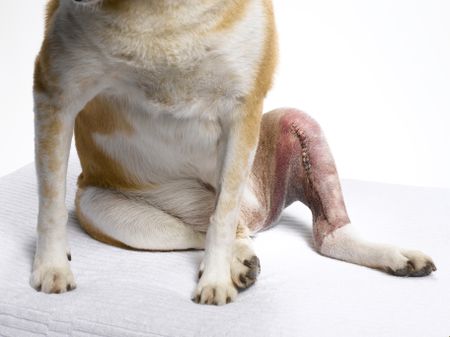Even if you do not play sports, you can have torn acls. Our dogs are no different. Despite the seemingly unlimited reserves of energy and dexterity, ACL rupture can occur when we least expect it and need immediate veterinary attention. Sometimes even surgery is required.
Let’s take a closer look at ACL injury in dogs, so that you were able to react in time. Why it is important you will find out during reading the article.
What is a CCL?
It is an important ligament in a dog’s knee joint. Ligaments stabilize the knee joint by preventing the tibia from moving in front of the thigh. In dogs, the CCL tends to undergo gradual changes, thereby weakening it before it bursts. This is different from human.
Where Is a Dog ACL Located?
It is located inside the knee joint and acts to stabilize the thigh on the lower leg. The ligament can be torn as a result of an acute traumatic event, or more often it breaks due to the slow progressive destruction of the ligament.
Dog ACL Injury Symptoms
The most noticeable symptom is sudden lameness. The dog will try not to step on the injured leg so that it does not touch the ground. Your dog will be in pain and therefore may whine. It will also happen if you touch the damaged area. This one of the main signs of torn ACL in dog and can develop in different ways: suddenly and gradually. If you find symptoms, contact your veterinarian immediately. You may also notice an abnormal sitting posture. For example, I used to bend your dog’s knees, but now it lies and tries to stretch its legs to the side. Thickening and swelling of the knee are also one of common symptoms. You can also hear the faint sound of a limp when your dog walks as one of the dog knee injury symptoms.
How to Tell If Dog Torn ACL?
In most cases, this damage can be a slow degradation caused by long-term trauma rather than a sudden rupture. Therefore, ligament injury is often a potential source of pain, mobility, and arthritis. It only takes a veterinarian a few minutes to make a correct diagnosis of torn ACL in dogs. However, there is a large percentage of erroneous diagnoses, so it is imperative to make an x-ray. During the checkup, your veterinarian will monitor your dog’s general mobility and look for signs of discomfort, fluid, or swelling in the knee. In addition, your veterinarian will assess if there is muscle loss. One leg larger than the other may indicate that the animal has not used that leg for a while. Most often, you will need the help of a narrower specialist after a diagnosis.
How to Treat ACL Injury in Dogs?
The treatment plan depends on your pet’s size.
- Dogs less than 30 pounds). Small dogs often do well without surgery. Your veterinarian may recommend that you hold your dog strictly for six weeks, may suggest that your dog lose weight if it is overweight, and may prescribe a short course of anti-inflammatory drugs. If your dog does not improve within 6-8 weeks, surgery may be recommended.
- Dogs over 30 pounds. Large dogs clearly benefit from surgery because medical treatment usually results in chronic lameness. There are many different surgical options. The basic principle of the operation is to stabilize the thigh on the lower leg. This can be achieved by placing implants in or around the knee joint, or by altering the dynamics of the joint itself. Your veterinarian may prefer a specific surgical technique or suggest a referral to a veterinarian surgical specialist for some of the more complex surgical procedures.
Home Treatment for ACL Tear in Dogs
If your dog is prescribed treatment, then you must provide comfort and peace to the pet at home. However, there is more trouble after the operation. You need to check the dog’s leg regularly for swelling and do not stress the dog for 6 weeks. Usually, after this time, you can gradually increase your dog’s physical activity until it returns to normal levels about sixteen weeks after surgery.
We would like to draw your attention to the prevention of canine ACL injury. Obesity can be a risk factor. Exercising regularly and keeping your dog at a healthy weight helps to minimize this risk. Even if it seems to you that the changes are insignificant, it is not worth the risk. See your veterinarian for a diagnosis. We wish you and your pet healthy and never hear this diagnose from veterinarians. Thank you for reading the article to the end. Expect new updates very soon. See you!

